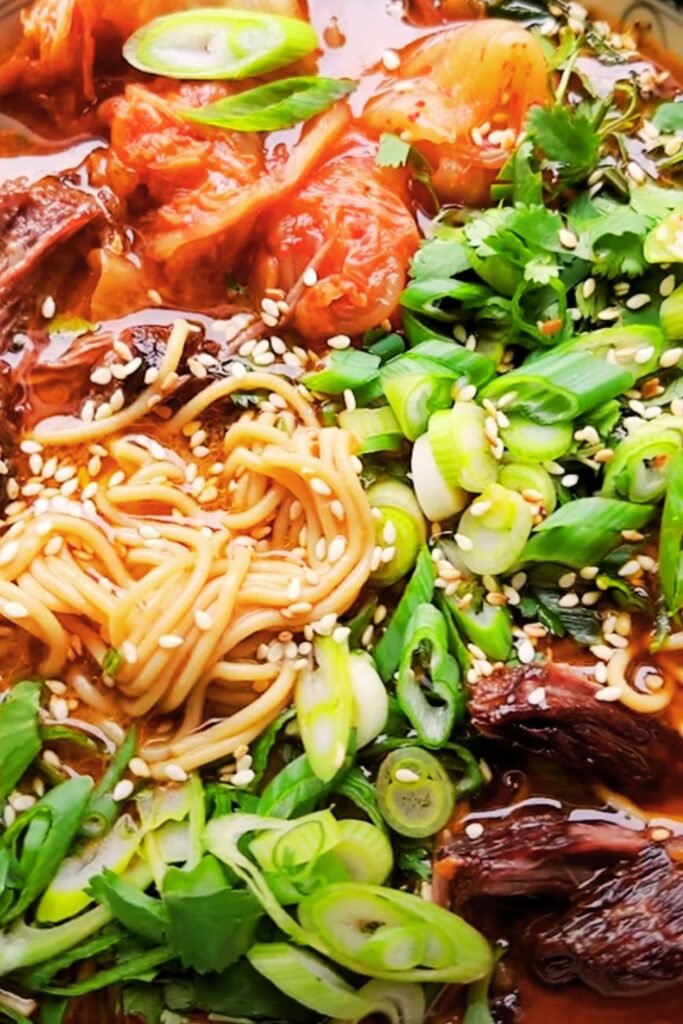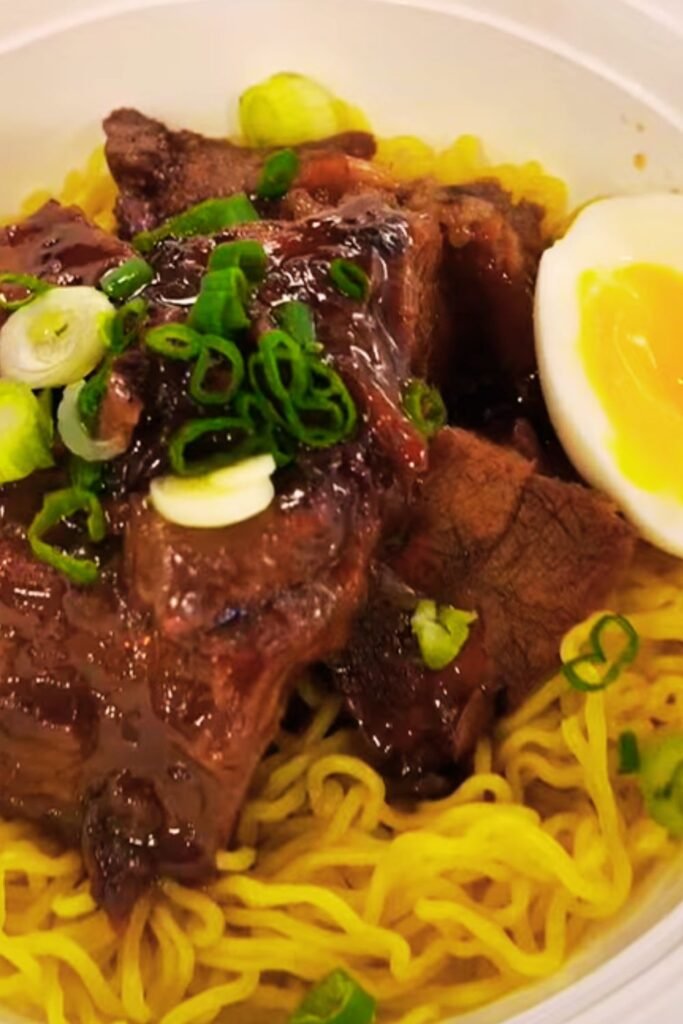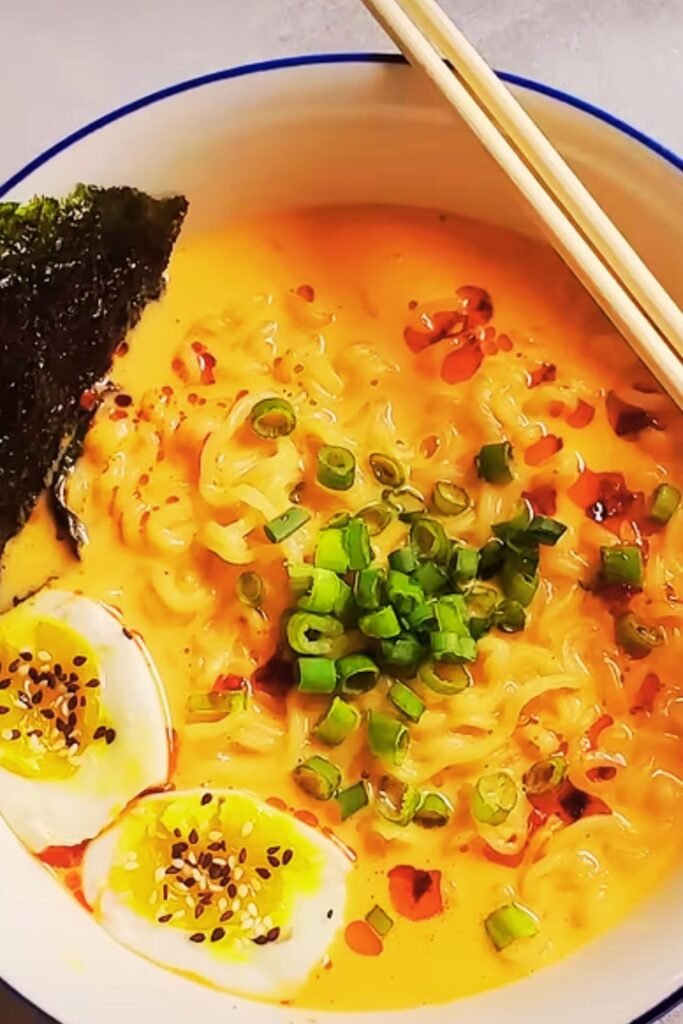There’s something magical about a steaming bowl of ramen that warms you from the inside out. As someone who’s spent years perfecting the art of homemade ramen, I’m thrilled to share my favorite creation: Spicy Short Rib Peanut Ramen. This isn’t your ordinary instant noodle upgrade—it’s a labor of love that transforms humble ingredients into something extraordinary.
When I first attempted this recipe, I was intimidated by the multiple components. But trust me, each element builds incredible depth of flavor, and the process can be broken down into manageable steps. The tender, fall-off-the-bone short ribs combined with a rich, spicy broth infused with peanut butter creates a harmony of flavors that will transport your taste buds to ramen heaven.
The Heart of Ramen: Understanding the Components
Before diving into the recipe, let’s break down what makes a truly exceptional bowl of ramen:
Broth : The soul of any ramen dish. Ours combines beef stock with aromatic ingredients and gets its distinctive richness from peanut butter and umami-packed ingredients.
Tare : A concentrated flavor bomb that seasons the broth. Our spicy version uses chili paste, soy sauce, and other bold ingredients.
Protein : Short ribs braised until meltingly tender, which gives this ramen its luxurious quality.
Noodles : Fresh ramen noodles are ideal, but good quality dried ones work wonderfully too.
Toppings : The finishing touch that adds texture, freshness, and visual appeal.
Let’s transform these components into a bowl that will make you forget every restaurant ramen you’ve ever had!
Ingredients
For the Short Ribs:
- 2 pounds bone-in beef short ribs
- 2 tablespoons vegetable oil
- 1 tablespoon kosher salt
- 1 teaspoon freshly ground black pepper
- 1 medium onion, roughly chopped
- 2 carrots, roughly chopped
- 2 celery stalks, roughly chopped
- 6 garlic cloves, smashed
- 2 tablespoons tomato paste
- 1/4 cup rice vinegar
- 1/4 cup soy sauce
- 2 tablespoons brown sugar
- 4 cups beef stock
- 2 bay leaves
- 1 cinnamon stick
- 3 star anise pods
For the Spicy Peanut Broth:
- Reserved braising liquid from short ribs (approximately 3 cups)
- 3 tablespoons red miso paste
- 1/3 cup natural peanut butter (unsweetened)
- 2 tablespoons gochujang (Korean chili paste)
- 2 tablespoons chili oil with sediment
- 1 tablespoon sesame oil
- 2 tablespoons soy sauce
- 2 tablespoons rice vinegar
- 1 tablespoon fish sauce
- 2 tablespoons honey
- 2 teaspoons freshly grated ginger
- 4 garlic cloves, minced
- 2 cups additional beef or chicken stock (for adjusting consistency)
For the Tare (Flavor Base):
- 1/4 cup gochujang
- 2 tablespoons doubanjiang (fermented broad bean paste)
- 3 tablespoons soy sauce
- 2 tablespoons mirin
- 1 tablespoon toasted sesame oil
- 2 teaspoons Sichuan peppercorns, toasted and ground
- 1 tablespoon brown sugar
For Assembly:
- 4 portions fresh or dried ramen noodles
- Reserved shredded short rib meat
- 4 soft-boiled eggs, halved
- 1 cup bean sprouts, blanched
- 1/2 cup thinly sliced green onions
- 1/4 cup chopped cilantro
- 1/4 cup crushed roasted peanuts
- Lime wedges
- Sliced red chilies
- Nori sheets, cut into strips
Equipment Needed
Having the right tools makes this recipe much more manageable:
- Dutch oven or large heavy-bottomed pot
- Fine mesh strainer
- Large mixing bowl
- Small saucepan
- Large pot for cooking noodles
- Ladle
- Tongs
- Sharp knife
- Cutting board
- Deep ramen bowls for serving

The Process: Step-by-Step Instructions
Step 1: Braising the Short Ribs (Can be done a day ahead)
- Preheat your oven to 325°F (165°C).
- Pat the short ribs dry with paper towels and season generously with salt and pepper.
- Heat vegetable oil in a Dutch oven over medium-high heat until shimmering.
- Working in batches if necessary, sear the short ribs on all sides until deeply browned, about 3-4 minutes per side. Transfer to a plate.
- Reduce heat to medium and add the onion, carrots, and celery to the pot. Cook until vegetables begin to soften, about 5 minutes.
- Add garlic and tomato paste, stirring constantly for about 1 minute until fragrant.
- Pour in the rice vinegar, scraping up any browned bits from the bottom of the pot.
- Return the short ribs to the pot and add soy sauce, brown sugar, beef stock, bay leaves, cinnamon stick, and star anise.
- Bring to a simmer, cover, and transfer to the oven.
- Braise for 2.5-3 hours, or until meat is fork-tender and falling off the bone.
- Remove from oven and let cool slightly. Transfer the short ribs to a cutting board.
- Strain the braising liquid through a fine-mesh sieve into a bowl, pressing on solids to extract all the flavor. Discard solids.
- When cool enough to handle, shred the meat and discard bones and excess fat. Cover and refrigerate if not using immediately.
- If preparing ahead, refrigerate the braising liquid separately so you can easily remove solidified fat from the surface before proceeding.
Step 2: Preparing the Spicy Peanut Broth
- Remove any solidified fat from the top of the chilled braising liquid (if prepared ahead).
- In a large pot, combine the strained braising liquid with miso paste and peanut butter over medium heat, whisking until smooth.
- Add gochujang, chili oil, sesame oil, soy sauce, rice vinegar, fish sauce, honey, ginger, and garlic.
- Simmer gently for 15-20 minutes to allow flavors to meld.
- Taste and adjust seasonings as needed. If the broth is too concentrated, add additional stock to reach desired consistency.
- Keep warm over low heat while preparing other components.
Step 3: Making the Tare
- In a small saucepan, combine all tare ingredients.
- Cook over medium-low heat, stirring frequently, for about 5 minutes until fragrant and slightly thickened.
- Remove from heat and set aside.
Step 4: Preparing the Ramen Eggs (Can be done a day ahead)
- Bring a small pot of water to a rolling boil.
- Gently lower eggs into water and cook for exactly 6 minutes and 30 seconds for a jammy center.
- Immediately transfer eggs to an ice bath to stop cooking.
- Once cooled, carefully peel the eggs.
- For extra flavor (optional): Soak peeled eggs in a mixture of 1/4 cup soy sauce, 1/4 cup mirin, and 1/4 cup water for at least 2 hours or overnight in the refrigerator.
Step 5: Cooking the Noodles
- Bring a large pot of water to a boil.
- Cook ramen noodles according to package instructions, being careful not to overcook. Fresh noodles may take only 1-2 minutes, while dried typically need 3-4 minutes.
- Drain well and divide among serving bowls.
Step 6: Assembly
- Place 1-2 tablespoons of tare in the bottom of each serving bowl.
- Ladle the hot spicy peanut broth over the noodles (about 1.5 cups per bowl).
- Arrange shredded short rib meat atop the noodles.
- Add half a ramen egg to each bowl.
- Garnish with bean sprouts, green onions, cilantro, crushed peanuts, lime wedges, red chilies, and nori strips.
- Serve immediately while piping hot.

Tips for Ramen Success
Achieving restaurant-quality ramen at home comes down to attention to detail. Here are my tried-and-true tips:
- Don’t rush the short ribs: The longer and slower they cook, the more tender and flavorful they become. This is where patience really pays off.
- Skim the fat: While some fat adds richness, too much can make the broth greasy. Refrigerating the braising liquid overnight makes it easy to remove excess fat.
- Balance is key: The perfect ramen broth has a balance of salt, umami, sweetness, acidity, and heat. Taste frequently and adjust as needed.
- Noodle timing matters: Slightly undercook your noodles since they’ll continue cooking in the hot broth. Nothing ruins ramen faster than mushy noodles.
- Serve in pre-warmed bowls: Cold bowls will quickly cool your ramen. Warm them by filling with hot water for a minute before emptying and filling with your ramen components.
- Eat immediately: Ramen waits for no one! The noodles continue absorbing broth and will become soggy if left too long.
Nutritional Information
For those watching their nutritional intake, here’s a breakdown of what you can expect from one serving of this Spicy Short Rib Peanut Ramen:
| Nutrient | Amount | % Daily Value* |
|---|---|---|
| Calories | 785 kcal | 39% |
| Protein | 48g | 96% |
| Total Fat | 42g | 54% |
| Saturated Fat | 12g | 60% |
| Cholesterol | 235mg | 78% |
| Carbohydrates | 58g | 21% |
| Dietary Fiber | 6g | 21% |
| Sugars | 14g | n/a |
| Sodium | 1850mg | 80% |
| Potassium | 820mg | 17% |
| Iron | 6mg | 33% |
| Calcium | 105mg | 8% |
| Vitamin A | 3200IU | 64% |
| Vitamin C | 18mg | 20% |
*Based on a 2,000 calorie diet
Make-Ahead and Storage Options
One of the beautiful aspects of this recipe is that many components can be prepared ahead of time:
Make Ahead:
- Short ribs and braising liquid: Can be prepared up to 3 days ahead and stored separately in the refrigerator.
- Ramen eggs: Best prepared 1 day ahead for optimal flavor infusion.
- Tare: Can be made up to 1 week ahead and stored in an airtight container in the refrigerator.
- Prepped garnishes: Most can be prepared a few hours ahead and stored in the refrigerator.
Storage:
- Leftover broth: Freezes beautifully for up to 3 months. Freeze in individual portions for quick future meals.
- Cooked short rib meat: Can be refrigerated for up to 3 days or frozen for up to 1 month.
- Complete assembled ramen: Does not store well as noodles become soggy. Best enjoyed immediately after assembly.
Variations to Try
The beauty of ramen is its adaptability. Here are some delicious variations to try:
Protein Alternatives:
- Substitute pork belly for short ribs
- Use chicken thighs braised in the same manner
- Add seared duck breast for a luxurious twist
- Make it vegetarian with braised mushrooms and tofu
Heat Level Adjustments:
- For milder ramen: Reduce gochujang and chili oil by half
- For extra spicy: Double the gochujang and add thinly sliced Thai bird chilies
- Add a dollop of homemade chili crisp on top for customizable heat
Regional Inspirations:
- Thai-inspired: Add lemongrass and lime leaves to the broth
- Japanese-inspired: Use miso and dashi as the broth base
- Chinese-inspired: Add Sichuan peppercorns and doubanjiang

Serving Suggestions
A bowl of this rich, spicy ramen can stand alone as a complete meal, but if you’re hosting a gathering, here are some complementary dishes:
- Cucumber Sunomono: A light, vinegary cucumber salad provides refreshing contrast
- Gyoza: Pan-seared dumplings make an excellent starter
- Simple Miso Soup: A light appetizer to prepare the palate
- Matcha Ice Cream: A cooling dessert to finish the meal
- Sparkling Water with Yuzu: A bright, citrusy beverage that cuts through the richness
Troubleshooting Common Issues
Even experienced cooks can encounter challenges when making ramen. Here’s how to solve the most common problems:
| Problem | Possible Cause | Solution |
|---|---|---|
| Broth too salty | Over-reduction or too much soy sauce/miso | Add more unseasoned stock or a small amount of water |
| Broth too bland | Insufficient reduction or seasoning | Add more tare or a splash of soy sauce; simmer longer to concentrate flavors |
| Broth too spicy | Too much chili paste or oil | Add more stock and a touch of honey to balance heat |
| Tough short ribs | Insufficient cooking time | Return to oven and continue braising until fork-tender |
| Greasy broth | Too much fat from short ribs | Chill broth to solidify fat and remove before reheating |
| Gummy noodles | Overcooked or left sitting too long | Cook noodles just under package time and serve immediately |
| Broth too thick | Too much peanut butter or over-reduction | Thin with additional stock |
| Eggs overcooked | Too much time in hot water | Reduce cooking time by 30-60 seconds |
The Cultural Significance of Ramen
While this spicy short rib peanut ramen is my own creation, it draws inspiration from various Asian culinary traditions. Ramen itself originated in China but became a cultural phenomenon in Japan, where each region developed its own distinctive style.
The addition of peanut butter in this recipe nods to Thai and Chinese influences, while the spicy elements pay homage to Korean cuisine. This fusion approach celebrates how food traditions evolve and mingle across cultures, creating new and exciting flavors while respecting traditional techniques.
What makes ramen so beloved worldwide is not just its delicious taste, but the communal experience it creates. There’s something deeply satisfying about watching someone enjoy a bowl of ramen you’ve prepared with care—the look of pleasure as they slurp the noodles and savor the complex broth.
Frequently Asked Questions
Can I make this recipe without a Dutch oven? Yes! You can use any heavy-bottomed, oven-safe pot with a tight-fitting lid. Alternatively, you can braise the short ribs in a slow cooker on low for 6-8 hours.
Is there a way to make this recipe less spicy but still flavorful? Absolutely. Reduce the amount of gochujang and chili oil, and increase the peanut butter slightly. The depth of flavor will remain while the heat level decreases.
Can I use a different cut of beef? Short ribs provide the ideal fat content and texture, but beef chuck or brisket can work well too. Just adjust cooking time accordingly—chuck may need a bit longer to become tender.
My broth separated and looks oily. How do I fix it? This can happen if the peanut butter doesn’t fully emulsify. Whisking vigorously while the broth is warm or using an immersion blender briefly can help create a smoother consistency.
Can I make this recipe gluten-free? Yes, use tamari instead of soy sauce, ensure your gochujang is gluten-free (or make your own), and use rice noodles or gluten-free ramen noodles.
How can I make a vegetarian version? Replace the short ribs with king oyster mushrooms and use vegetable stock instead of beef stock. You’ll also need to substitute the fish sauce with a vegetarian alternative like liquid aminos with a touch of mushroom powder.
Is there a quicker version for weeknights? Yes! Use a pressure cooker for the short ribs (45-50 minutes at high pressure), or substitute with ground beef cooked with similar seasonings for an even quicker option. You can also use pre-made stock and focus on the flavoring components.
What if I can’t find gochujang or doubanjiang? Substitute gochujang with sriracha mixed with a bit of miso paste. For doubanjiang, you can use a mixture of miso paste and chili paste as an alternative.
Final Thoughts
Creating this Spicy Short Rib Peanut Ramen is truly a labor of love. While it requires time and attention to detail, the process itself becomes meditative—the slow building of flavors, the careful preparation of each component, and finally, the artistic assembly of the bowl.
What I love most about this recipe is its ability to bring people together. There’s something almost ceremonial about serving someone a bowl of ramen you’ve crafted from scratch. As they take that first slurp of noodles and broth, you’ll see their eyes close in appreciation, and you’ll know every minute spent was worthwhile.
So set aside a weekend afternoon, gather your ingredients, and embark on this culinary adventure. Your taste buds—and anyone lucky enough to share in the meal—will thank you. And remember, the best ramen isn’t just about following a recipe perfectly; it’s about putting your heart into every step of the process.